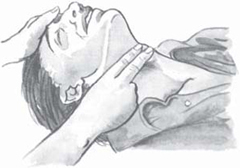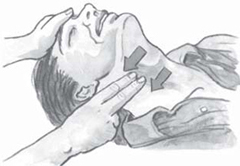First Aid
3. The Pulse
The pulse is a vital sign that provides information on the circulatory system and the functioning of the heart. The pulse must be regular and rhythmical and be perceived to have a certain intensity.
If we take the number of beats in one minute, we shall know the heart rate. The normal resting heart rate in an adult is 60 -
80 beats per minute. When the pulse is weak, fast (more than 120 beats per minute), or is not rhythmical, this is a sign that something is failing in the circulatory system.
The pulse should be taken with two fingers: the index and middle fingers. The index finger is used to press the artery against the bone, using the middle finger to perceive the pulse. There are different points where the pulse may be taken.
When the point where the pulse is taken is far from the heart, we are taking a peripheral pulse (e.g. the radial pulse). If the area where the pulse is taken is near to the heart, the pulse if central (e.g. the carotid pulse).
The peripheral pulse disappears when the blood pressure or arterial pressure is low (e.g. on fainting), and this can lead us to think that the heart has stopped. That is why the peripheral pulse should only be used in people who are well.
 |
 |
| Feel the Adam’s apple | Slide your fingers to the depression near to it |
REMEMBER:
- In emergency situations the central pulse (carotid pulse) should be taken first, as this does not disappear under low blood pressure conditions.
- The absence of a pulse (central/carotid) means that cardiac arrest has occurred. The pulse should be taken for at least 5 seconds to be sure of its absence.




